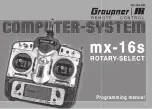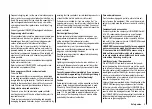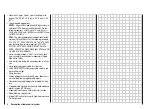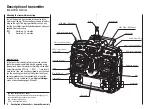
4
Safety notes
Before you switch on the receiver, ensure that the thrott-
le stick is at the stop / idle end-point.
Always switch on the transmitter fi rst, and only then
the receiver.
Always switch off the receiver fi rst, and only then
the transmitter.
If you do not keep to this sequence, i.e. if the receiver
is at any time switched on when “its” transmitter is swit-
ched OFF, then the receiver is wide open to signals from
other transmitters and any interference, and may re-
spond. The model could then carry out uncontrolled mo-
vements, which could easily result in personal injury or
damage to property. The servos may run to their end-
stops and damage the gearbox, linkage, control sur-
face etc.
Please take particular care if your model is fi tted with a
mechanical gyro:
Before you switch your receiver off, disconnect the po-
wer supply to ensure that the motor cannot run up to
high speed accidentally.
As it runs down, the gyro can generate such a high
voltage that the receiver picks up apparently valid
throttle commands, and the motor could respond by
unexpectedly bursting into life.
Range checking
Before every session check that the system works pro-
perly in every respect, and has adequate range. This
means checking that all the control surfaces respond
correctly and in the appropriate direction to the transmit-
ter commands at a suitable ground range. Repeat this
check with the motor running, while a friend holds the
model securely for you.
Operating your model aircraft, helicopter, boat or car
Never fl y directly over spectators or other pilots, and
take care at all times not to endanger people or animals.
Keep well clear of high-tension overhead cables. Never
operate your model boat close to locks and full-size ves-
sels. Model cars should never be run on public streets or
motorways, footpaths, public squares etc..
Checking the transmitter and receiver batteries
It is essential to stop using the radio control system and
recharge the batteries well before they are completely
discharged. In the case of the transmitter this means –
at the very latest – when the message “
Battery must be
charged
” appears on the screen, and you hear an au-
dible warning signal.
It is vital to check the state of the batteries at regular in-
tervals – especially the receiver pack. When the batte-
ry is almost fl at you may notice the servos running more
slowly, but it is by no means safe to keep fl ying or run-
ning your model until this happens. Always replace or re-
charge the batteries in good time.
Keep to the battery manufacturer’s instructions and don’t
leave the batteries on charge for longer than stated. Do
not leave batteries on charge unsupervised.
Never attempt to recharge dry cells, as they may explo-
de.
Rechargeable batteries should always be recharged be-
fore every session. When charging batteries it is impor-
tant to avoid short-circuits. Do this by fi rst connecting the
banana plugs on the charge lead to the charger, taking
care to maintain correct polarity. Only then connect the
charge lead to the transmitter or receiver battery.
Disconnect all batteries and remove them from your mo-
del if you know you will not be using it in the near future.
Capacity and operating times
This rule applies to all forms of electrical power source:
battery capacity is reduced every time you charge the
pack. At low temperatures capacity is greatly reduced,
i.e. operating times are shorter in cold conditions.
Installing control linkages
The basic rule is that all linkages should be installed in
such a way that the pushrods move accurately, smooth-
ly and freely. It is particularly important that all servo out-
put arms can move to their full extent without fouling or
rubbing on anything, or being obstructed mechanically
at any point in their travel.
It is important that you should be able to stop your mo-
tor at any time. With a glow motor this is achieved by ad-
justing the throttle so that the barrel closes complete-
ly when you move the throttle stick and trim to their end-
points.
Ensure that no metal parts are able to rub against each
other, e.g. when controls are operated, when parts rota-
te, or when motor vibration affects the model. Metal-to-
metal contact causes electrical “noise” which can interfe-
re with the correct working of the receiver.
Always extend the transmitter aerial fully before
operating your model.
Transmitter fi eld strength is at a minimum in an imagina-
ry line extending straight out from the transmitter aeri-
al. It is therefore fundamentally misguided to “point” the
transmitter aerial at the model with the intention of obtai-
ning good reception.
When several radio control systems are in use on adja-
cent channels, the pilots should always stand together in
a loose group. Pilots who insist on standing away from
the group endanger their own models as well as those
of the other pilots.
Pre-fl ight checking
If there are several modellers at the site, check carefully
with all of them that you are the only one on “your” chan-
nel before you switch on your own transmitter. If two mo-
dellers switch on transmitters on the same channel, the
result is invariably interference to one or both models,
and the usual result is at least one wrecked model.
Safety notes
Summary of Contents for MX-16S
Page 1: ...1...
Page 17: ...17...
Page 31: ...31 Fixed wing models Installation and connections...
Page 35: ...35 Program description Reserving a new memory...
Page 47: ...47 Base settings Model helicopter...
Page 83: ...83 Fail safe...
Page 89: ...89 Programming examples Fixed wing model...
Page 109: ...109 Programming examples Model helicopter...
Page 112: ...112 112...
Page 116: ...116...





































